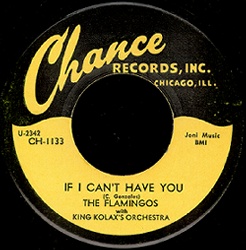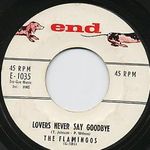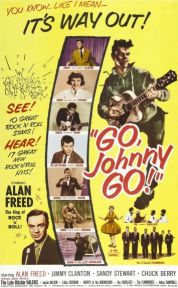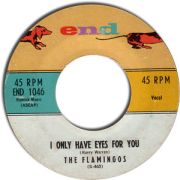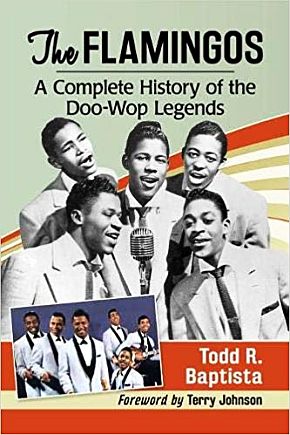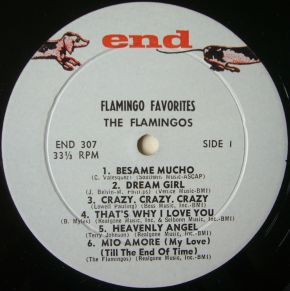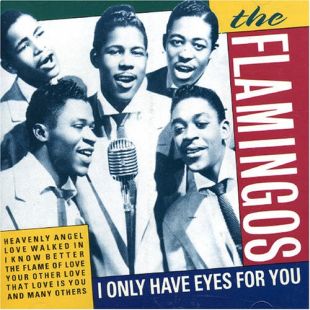
The Flamingos of the late 1950s shown on the cover of a 1997 CD featuring a compilation of 18 of their songs. Click for CD.
However, the Flamingos’ 1959 version gave the song a whole new dimension. Set in the “doo-wop” style of its day, their “deep-echo” version proved to have broad national appeal, rising on both the rhythm & blues (R&B) and pop charts.
Music Player
1959 – The Flamingos
Today, the Flamingos’ “I Only Have Eyes For You” continues to resonate with many listeners, young and old. Music historians of the 1950s regard the song as a classic.
For some listeners, the song offers a “take-you-away” musical immersion, and for a few, a near-hypnotic, otherworldly experience. Listen to this Flamingos’ song on the music player above and judge for yourself.
Chicago Roots
The Flamingos were formed from a group of friends and relatives on Chicago’s southside in the early 1950s. They began recording in 1953, and became a group with a long list of recordings, working with a number of record labels, including Chance, Parrot, Chess/Checker, Decca, End, and others. And although they never had a No. 1 hit on the pop charts — coming close several times — they are regarded as one of the classic “doo wop” groups of their day, noted for their exceptional harmonies and unique sound. By the time “I Only Have Eyes for You” hit the streets in April/May 1959, the group was comprised of six members: founding “cousins” Jake and Zeke Carey, Terry Johnson, Paul Wilson, Tommy Hunt, and Nate Nelson. In 1958, the group had been recording with the Chess/Checker label in Chicago, but after relocating to New York City, they soon hooked up with a record producer there named George Goldner who helped the group score with some of their biggest hits in the late 1950s and early 1960s.
George Goldner
Goldner was considered one of the biggest record hustlers of his day, also among the biggest producers of what would be called “doo wop” records. Goldner was not a rock ‘n roll fan, per se, but had Latin and jazz musical influences in his past. He had worked with Tico, a label that specialized in Latin artists, during the late 1940s. He had also worked with some early rock ‘n roll artists, as well, and had an ear for pop hits.
Much of Goldner’s success had come with producing and releasing singles. But he was also among those who liked to market “packages” of songs, or LPs, as albums were called in those days. In late 1956, he had released one of the first doo-wop albums, Teenagers, on the Gee record label. And by 1959, working with other artists, he had released a 12-track album by The Chantels, and another by Little Anthony & The Imperials. These two groups would later become successful and well known in their own right. The Flamingos, meanwhile, had come to Goldner after an unsatisfying period with their then-current record label, Decca, which they had joined in1957.

Geo. Goldner, the producer who helped The Flamingos.
“…George Goldner wanted us to go in another direction than regular R&B. He wanted us to do standards like the Platters, who were doing songs like ‘Smoke Gets in Your Eyes.’ I was open to the idea, because I wasn’t raised on R&B; my parents listened to Patti Page, the Mills Brothers, the Ink Spots and Bing Crosby. When George said he wanted me to change the structure of the songs and give them a nice flavor, I was excited because it was such a good challenge for me.”
Goldner, in fact, took Richard Barrett to a music store and bought up the sheet music to every old song he could find, turning them over to Terry Johnson to arrange new songs for the Flamingos. One of the first songs the Flamingos did with Goldner that hit the pop charts was “Lovers Never Say Goodbye”, written by Terry Johnson, who shared the lead on the song with Paul Wilson. On the B-side was “That Love Is You”, with Nate Nelson in the lead. “Lovers Never Say Goodbye” reached No. 25 on the R&B charts and No. 52 on the pop countdown.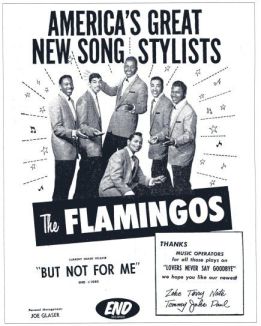
1958-59 magazine ad for Flamingos’ music by End Records, with lower corner box thanking radio DJs for playing their hit, ‘Lovers Never Say Goodbye.’
As the album and its songs went into production for the next few months, the Flamingos did some performing in New York. Meanwhile, one of the Flamingos earlier record labels, Checker, seeing that the group was capable of turning out hits, decided to put out a single with two earlier-recorded but unreleased songs in January 1959. Checker would also issue a Flamingos LP the following month. But by this date, sales of their new single with Goldner — “Lovers Never Say Goodbye” — was already having considerable success. In January alone, it helped push Goldner’s labels to the one-million level in total sales. February was even better. More success was about to come with the forthcoming album, Flamingo Seranade.
In mid-January 1959, meanwhile, The Flamingos booked into New York’s Apollo theater where they had played a number of times before. Other notable performers appearing at the Apollo at that time included: Jerry Butler, the Crests, Little Anthony and the Imperials, the Quin-Tones, Wade Flemons, Doc Bagby, and Clay Tyson.In February 1959, the Flamingos were filmed in a New York studio singing and dancing to a lively version of another of their songs, “Jump, Children.” This song, along with the Flamingos’ dance routine, would appear in a movie with disc jockey Alan Freed — a movie titled, Go Johnny Go! This was the second Alan Freed movie the Flamingos had appeared in, the first being Rock, Rock, Rock of December 1956, which also included stars such as Chuck Berry and Connie Francis.
The Flamingos at this point, had also become well known for their stage show and choreography. Later groups that used choreography in their acts, such as The Temptations of the 1960s, would cite the Flamingos as a major influence. The film Go Johnny Go! would appear in theaters through mid-1959. The Flamingos’ debut album, meanwhile, Flamingo Serenade, was released in April 1959 on Goldner’s End record label.
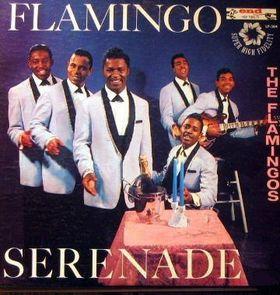
The Flamingos’ 1959 album of old standards, ‘Flamingo Serenade;’ includes their big hit, ‘I Only Have Eyes For You.’ Click for CD or digital.
“I Only Have Eyes for You” peaked at No. 11 on the Billboard pop chart in June 1959, and rose to No.3 on the R&B chart. With its shimmering “doo-bop sh-bops” in the echo chamber, and Nate Nelson’s clear, distinctive lead, the record became a classic, and remains one of the most popular oldies of all time.
“I Only Have Eyes for You” is also said to have been The Flamingos’ favorite recording, regarded as one of those moments in the studio when everything came together for a superb production.
For George Goldner, the Flamingos proved to be among his most successful groups. They had at least eight singles on the End label that reached the pop charts, including a Top 30 hit in 1960, “Nobody Loves Me Like You Do.” They also turned out three full albums on the End label in addition to Flamingo Serenade, including: Flamingo Favorites (1960), Requestfully Yours (1960), and The Sound of the Flamingos (1962).“I Only Have Eyes For You,” however, remains the classic hit single. In November 2004, Rolling Stone magazine ranked the Flamingos’ version of the song at No #157 on their “500 Greatest Songs” list. The Flamingos’ version was also used on the soundtrack for the 1973 film, American Graffiti.
Fans Love It
To this day, the “Flamingos sound” has a very loyal following. And some who hear The Flamingos’1959 version of “I Only Have Eyes for You” come away with a lasting impression, as did one fan named “Larry,” who wrote about his experience with this Flamingos’ song on the blog, Funky16 Corners:
|
“I Only Have Eyes My love must be a kind of blind love Are the stars out tonight? The moon maybe high I don’t know if we’re in a garden, You are here, and so am I |
“…I can’t be one hundred percent certain of the first time I ever heard ‘I Only Have Eyes For You’ by the Flamingos, but I’m guessing it was when I saw American Graffiti in 1973. I was only eleven years old, but as soon as this song came on the soundtrack it was instantly drilled deep into the pleasure centers of my brain. As I got older, and started to understand something of how records were made, my deep respect for the astounding level of craft involved in the making of ‘I Only Have Eyes For You’ has grown every time I hear it.
“There’s something special about the spare instrumentation — pretty much just piano, drums and guitar — contrasted with a rich, velvety blanket of human voices, all of it arranged to perfection… that simply blows my mind.
“I’ve always had a love for what might be (if only in my own mind) considered “night time” records that sound as if they were recorded in the wee small hours specifically for use in that same time period, whether for lovers or those engaged in solitary meditation, and ‘I Only Have Eyes For You’ is the ne plus ultra of that very specific subgenre…
“…It’s almost the musical equivalent of a meditative exercise, where you just close your eyes, allow yourself to be enveloped by the music …and just kind of feel it. Whether the Flamingos intended it or not, this record is possessed of a kind of otherworldly magic….”
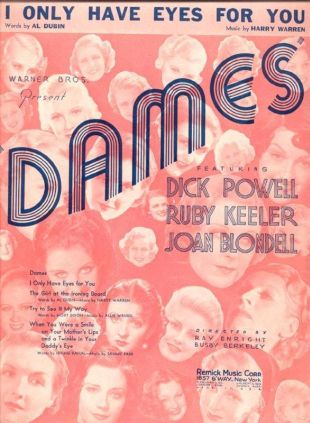
Cover of sheet music featuring ‘I Only Have Eyes for You’ from the 1934 Warner Brothers film, ‘Dames’. Click for film.
Song Origin & Covers
The Flamingos, of course, were not the first group to record “I Only Have Eyes For You.” The song, in fact, was written in 1934 for the film Dames starring Dick Powell and Ruby Keeler. It was composed by Harry Warren and lyricist Al Dubin. The song plays throughout the film’s soundtrack and is featured in two scenes. Powell first sings it to Ruby Keeler on the Staten Island ferry, expressing bedazzlement; and that he “only has eyes” for her. The second time the song appears, Powell is riding the subway and sees Keeler’s face everywhere he looks. The dream sequence that follows in the film features a elaborate dance scene by famed Hollywood choreographer and co-director Busby Berkeley. The dancers in the scene at one point all wear Ruby Keeler masks.
In 1934, the song also charted in three versions — at No. 2 with Ben Selvin and His Orchestra, Howard Phillips vocal; No. 4 with Eddy Duchin and His Orchestra, Lew Sher- wood vocal; and No. 20 with Jane Froman. And for years thereafter, the song would be covered by a number of other artists. Billy Eckstine recorded the song on National Records in 1949. Peggy Lee also did it in 1950. In May 1952, the Swallows out of Baltimore, Maryland did an R&B version on King Records, somewhat slower than the Flamingos’ version. The Swallows’ recording is still available today and can be sampled online. Other R&B artists also did versions of the song as well. But R&B tunes generally suffered during segregation, and only began to be heard on some pop radio stations in the mid-1950s.
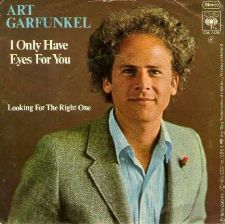
Art Garfunkel’s 1975 version of ‘I Only Have Eyes For You’ hit No. 1 in the U.K. and U.S. Adult Contemporary chart. Click for MP3.
In 1976, Johnny Mathis named an album after the song. It was also featured in the 1980-81 Broadway revival of the Tony award-winning musical 42nd Street. In 1990, the Count Basie Orchestra recorded it with George Benson. And since then, still others have made cover versions, including: Mercury Rev in 1998, Martina Topley-Bird, Jamie Cullum, and Mark Eitzel of American Music Club in 2002. But the 1959 version of the song has remained popular, and has also found its way into other venues.
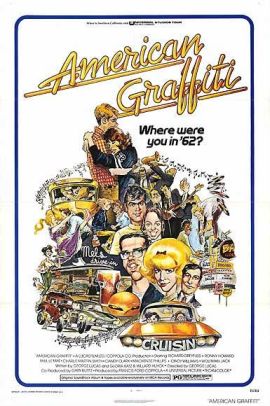
1973 film, ‘American Graffiti’ used the Flamingos’ song, among others from the 1950s & ’60s. Click for film.
Film & TV
The Flamingos’ version of “I Only Have Eyes For You” has been used in a number of films, including: American Graffiti (1973), The Right Stuff (1983), One Good Cop/One Man’s Justice (1991), My Girl (1991), Heart and Souls (1993), A Bronx Tale (1993), Milk Money (1994), Past Tense (1994-TV), Four Dogs Playing Poker (2000), Cherish (2002), and Something’s Gotta Give (2003). On television, too, The Flamingos’ version has also been used, as in one 1998 episode of Buffy the Vampire Slayer and also in The Sopranos series during 1999.
The Flamingos’ song has also been used to give expression to experimental and artistic film making. In 2002, an exhibit titled “Revelation,” at the Perth, Australia International Film Festival, posted the description below of a short, seven-minute film by Tom Jarmusch and Fabienne Gaultier (USA/France) that used the Flamingos’ “I Only Have Eyes For You” in its production:
“…Jarmusch and Gaultier collaborate to (re)produce their multiple screen installation work for cinema viewing — and an excellent work it is. Using multiple film and video formats including 16mm, domestic video and a toy video camera, they have produced a hypnotic work with a wonderful tactile nature. Structured around the Flamingos’ tune “I Only Have Eyes For You,” it is a strangely poetic and layered experimental work which literally compels the audience to watch. Described as a “triple screen city symphony” its lyrical quality is alluring and wonderfully hypnotic.”
However, not all uses of Flamingos’ “I Only Have Eyes For You” have been approved or authorized by the group or their estates.
Pepsi Lawsuit
In 1997, Pepsi-Cola used the Flamingos’ 1959 version of “I Only Have Eyes For You” in a television commercial that ran nationwide for about six months. In 2003, two surviving members of The Flamingos, Terry Johnson and Tommy Hunt, and the estates of the deceased members, brought a lawsuit against Pepsi for the alleged wrongful action. They were represented by San Francisco entertainment lawyer Steven Ames Brown.
A collective bargaining agreement made with the American Federation of Television and Radio Artists requires advertisers to get permission for commercial use of music, and to pay fees to the music publishers, the record labels, and the artists. In 2006, a judge ordered Pepsi and its advertising company to pay $250,000 to The Flamingos for using their song in a TV ad without their permission. “In our case, they didn’t even ask,” said San Francisco attorney Brown, in a later interview with Associated Press.
In 2006, a judge ordered PepsiCo Inc. and its advertising company to pay $250,000 to the The Flamingos for using “I Only Have Eyes For You” without their permission. According to Brown, it wasn’t the first time that Pepsi neglected to pay a recording artist for a song. He charged that Pepsi failed to pay black performers for their songs before. “Pepsi routinely pays the Caucasian performers who appear on camera but refuses to pay the African-American singers whose voices are used in the soundtrack unless they sue,” Brown said. Brown had successfully sued Pepsi on a previous occasion on behalf of singer Doris Troy, whose 1963 hit “Just One Look” was used in another popular Pepsi commercial with supermodel Cindy Crawford that featured two young boys.
A spokesman for Pepsi said the failure to pay The Flamingos directly was an oversight and that Pepsi didn’t realize the song was subject to the collective bargaining agreement. “We have a long history and strong track record of supporting diversity in our advertising,”said Dave DeCecco of the Purchase, New York-based PepsiCo Inc.
The Flamingos
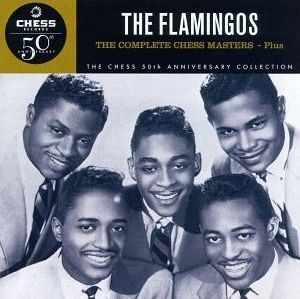
A 1997 CD of Flamingos’ songs on Chess Records, issued as part of the Chess 50th Anniversary Collection. Click for digital.
See also at this website, “Dion DiMucci, 1950s-2002,” for another exploration of the 1950s-1960s “doo-wop” sound, and also “1960s Girl Groups,” for the rise and evolution of that musical genre. Beyond these, see the “Annals of Music” page for additional story choices in that category. Thanks for visiting – and if you like what you find here, please make a donation to help support the research and writing at this website. Thank you. – Jack Doyle
|
Please Support Thank You |
_________________________
Date Posted: 25 May 2009
Last Update: 11 February 2019
Comments to: jdoyle@pophistorydig.com
Article Citation:
Jack Doyle, “I Only Have Eyes For You,”
PopHistoryDig.com, May 25, 2009.
____________________________________
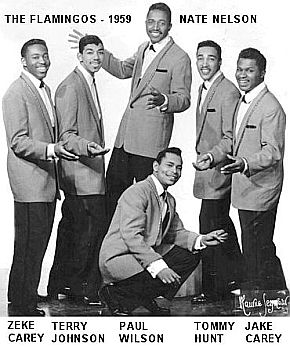 Composition of The Flamingos’ group in 1959. |
“I Only Have Eyes For You — The Flamingos,” The Doo Wop Box: 101 Vocal Group Gems From the Golden Age of Rock ‘n Roll, (liner notes booklet), Rhino Records Inc, 1993, p. 64.
Marv Goldberg, “The Flamingos,” Marv Goldberg’s R&B Notebooks, Based on interviews with Johnny Carter and Terry Johnson, 2006.
Jason Ankeny, “The Flamingos,” All Music Guide.
“The Flamingos,” Wikipedia.org.
“The Flamingos,” Vocal Group Hall of Fame, Inducted, 2000.
Sandra Burlingame, “I Only Have Eyes for You (1934),” JazzStandards.com.
David Edwards and Mike Callahan, “The George Goldner Story,” BsnPubs.com, last update, January 26, 2009.
David Edwards and Mike Callahan, “End Label Album Discography,” BsnPubs.com, last update, February 28, 2008.
Robert Pruter, “The Flamingos: The Chicago Years,” Goldmine (magazine) April 6, 1990, pp. 28-30. (Goldmine.com is also a music and music memorabilia website featuring articles on recording stars of the past and present, listing all known releases. Goldmine, the bi-weekly print magazine, also distributes a weekly e-newsletter, and broadcasts streaming radio.)
Larry, “The Flamingos — I Only have Eyes For You,” Funky16 Corners, June 12, 2008.
Kim Curtis, Associated Press, “The Flamingos Wins Settlement From Pepsi For Unauthorized Song in Ad,” TargetMarket News.com, January 30, 2006.
Associated Press, “Doo-Wop Band Wins Settlement From Pepsi,” USA Today, January 30, 2006.
“The Flamingos,” HarmonyTrain.com.
“Pepsi Must Pay for Flamingos Song,” Los Angles Times, February 1, 2006.
Stephen Cook, Album Review, I Only Have Eyes for You: The Best of The “End” Years, The Flamingos ( Sequel, 1994), All Music.com.
Anthony J. Gribin, Andrew M. Schoff & Matthew M. Schiff, The Complete Book of Doo-Wop, Wisconsin: Krause Publications, 2000.
Robert Pruter. Doo-Wop: The Chicago Scene, Champaign, IL: University of Illinois Press, 1996.
“The Flamingos,” Rock and Roll Hall of Fame, Induction, March 19, 2001.
“I Only Have Eyes For You,” 2002 Films/Short Film Showcase, Revelation Perth International Film Festival.
J.C. Marion, “The Flamingos, Part 2: Decca, End, and Beyond,” Doo-Wop Nation, Issue #6.
“The 500 Greatest Songs of All Time,” Rolling Stone, November-December 2004.
Terry Johnson’s Flamingos History.
“I Only Have Eyes for You,” Wikipedia.org
